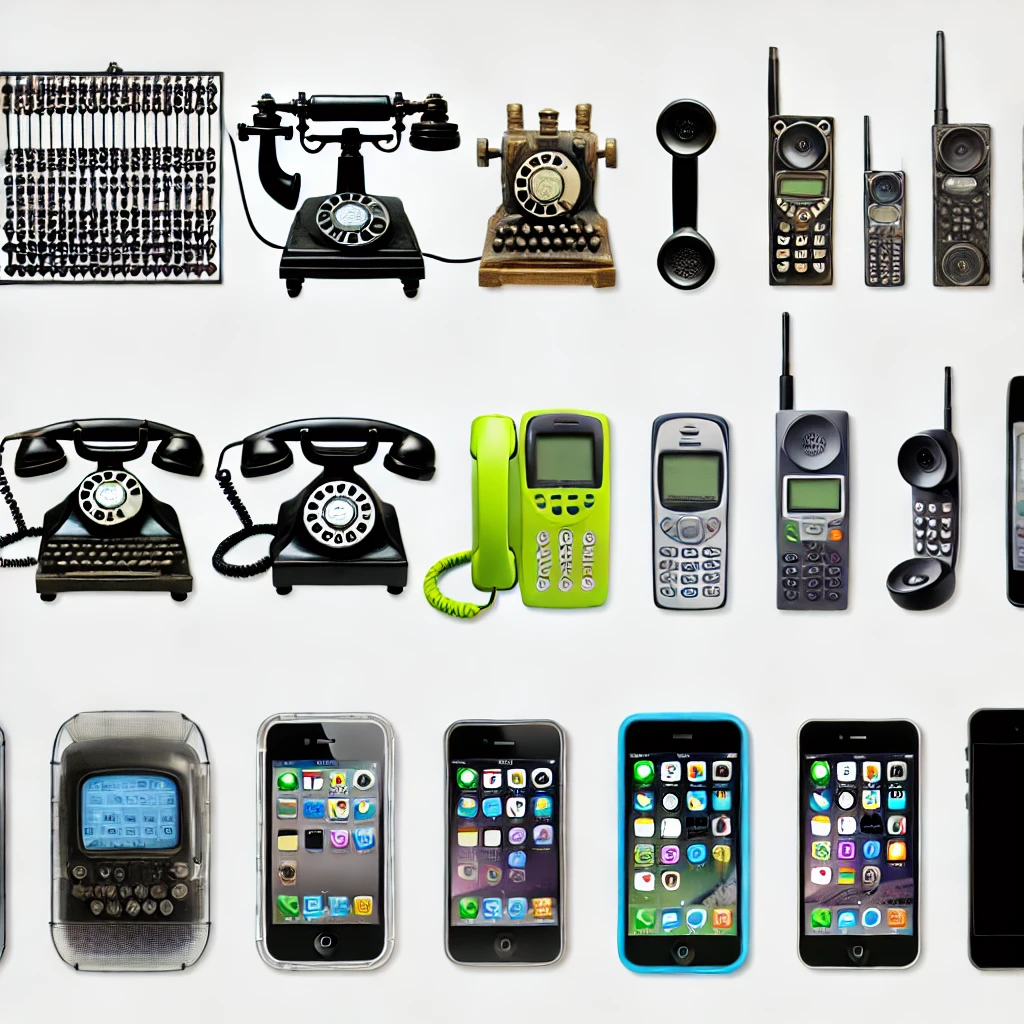Phone technology has dramatically evolved over the past century, transforming from rudimentary communication tools to powerful, multifunctional devices that play a central role in modern life. The phone’s journey began in the 19th century with the invention of the telegraph and has since progressed through several key stages, including the development of landline phones, mobile phones, and the smartphones we use today. This article explores the history of phone technology, its technological advancements, and its impact on society. To learn more you may visit korea-mobile.kr.
The Early Days: Telegraph and Telephone
Before the invention of the telephone, long-distance communication relied on the telegraph, a device that transmitted electrical signals over a wire between stations. Invented by Samuel Morse in 1837, the telegraph revolutionized communication by allowing messages to be sent across great distances. However, the telegraph had its limitations, primarily because it could only transmit text-based messages using Morse code.
In 1876, Alexander Graham Bell made a groundbreaking discovery by inventing the telephone, a device that could transmit the human voice over long distances through electrical signals. This was a significant improvement over the telegraph, as it allowed for real-time conversation between two people. The telephone quickly gained popularity, and by the late 19th century, telephone networks were being established in cities around the world.
The Landline Era
The early 20th century saw the widespread adoption of landline telephones, which became a fixture in homes and businesses. The first telephones were operated manually by switchboard operators who connected calls by plugging cables into different circuits. This system was eventually automated, allowing users to dial numbers directly without the need for an operator.
During this era, phone technology improved in several ways. Innovations such as rotary dial phones, touch-tone dialing, and voice mail became standard features. The expansion of telephone networks, coupled with the advent of fiber-optic cables, enabled faster and more reliable communication across greater distances.
One of the most significant developments during this period was the introduction of long-distance calling, which allowed people to communicate with others outside their local area. International calling further expanded the reach of phone communication, linking people from different countries and continents.
The Birth of Mobile Phones
The idea of mobile communication was first explored in the early 20th century, but it wasn’t until the 1970s that mobile phones became a reality. The first mobile phone, the Motorola DynaTAC 8000X, was introduced in 1983. It was a bulky, brick-like device with limited functionality, primarily used by business professionals who needed to communicate on the go.
Despite its limitations, the DynaTAC represented a major leap in phone technology. It was the first device that allowed users to make calls without being tethered to a landline, paving the way for the mobile phone revolution. Over the next few decades, mobile phones became smaller, more affordable, and more widely available to the general public.
The Rise of Cell Phones
The 1990s marked the beginning of the cell phone era. Cell phones, which use a network of radio towers to transmit signals, offered greater mobility and convenience compared to landline phones. Early cell phones were primarily used for voice communication, but technological advancements soon added new features such as text messaging, caller ID, and voicemail.
One of the most important developments during this period was the transition from analog to digital technology. Digital cell phones offered clearer sound quality, better security, and increased network capacity. The introduction of the Global System for Mobile Communications (GSM) standard in the early 1990s enabled international roaming, allowing users to use their phones in different countries.
By the end of the 1990s, cell phones had become a common sight, with millions of people around the world using them for everyday communication. The stage was set for the next major leap in phone technology: the smartphone.
The Smartphone Revolution
The term “smartphone” was first used in the late 1990s to describe phones with advanced features beyond voice communication. Early smartphones, such as the Nokia 9000 Communicator and the BlackBerry, were primarily used by business professionals for email and basic internet access. However, these devices were limited in terms of functionality and user experience.
The true smartphone revolution began in 2007 with the launch of the Apple iPhone. The iPhone, designed by Steve Jobs and his team at Apple, was a game-changer in the world of phone technology. It combined a sleek design with a touch-screen interface, a powerful operating system, and access to the internet, apps, and media. The iPhone’s introduction marked the beginning of a new era in phone technology, where phones became multipurpose devices capable of handling a wide range of tasks, from communication and entertainment to productivity and navigation.
The success of the iPhone spurred the development of competing smartphones, including devices running on Google’s Android operating system. Android, an open-source platform, quickly gained popularity due to its flexibility and wide range of available devices. Together, iOS and Android now dominate the smartphone market, accounting for the vast majority of smartphones in use today.
Key Features of Modern Smartphones
Modern smartphones are far more than just communication tools; they are pocket-sized computers with a range of powerful features. Some of the key features of today’s smartphones include:
- Touchscreens: Nearly all smartphones feature touchscreens, allowing users to interact with their devices through taps, swipes, and gestures. Touchscreens provide a more intuitive and versatile user experience compared to traditional physical buttons.
- High-Resolution Displays: Smartphones come equipped with high-resolution displays, often featuring OLED or AMOLED technology, which delivers vibrant colors and deep contrast. These displays are ideal for viewing photos, videos, and other multimedia content.
- Cameras: One of the most important features of modern smartphones is their cameras. Smartphones now feature multiple high-quality cameras, including wide-angle, telephoto, and macro lenses. The integration of advanced camera software enables users to take professional-quality photos and videos.
- Apps: The rise of app stores, such as the Apple App Store and Google Play Store, has transformed smartphones into versatile tools. There are millions of apps available for smartphones, covering everything from social media and entertainment to health and fitness, productivity, and education.
- Mobile Internet: Smartphones are equipped with mobile data capabilities, allowing users to access the internet from virtually anywhere. The advent of 4G and 5G networks has dramatically increased internet speeds, enabling seamless streaming, video calls, and online gaming.
- Artificial Intelligence: Modern smartphones are powered by artificial intelligence (AI) and machine learning algorithms that enhance their functionality. AI is used in features such as voice assistants (e.g., Siri, Google Assistant), facial recognition, and predictive text input.
- Biometric Security: Smartphones now come with advanced security features, including fingerprint scanners, facial recognition, and iris scanners, ensuring that only authorized users can access the device.
- Battery Life: As smartphones have become more powerful, manufacturers have developed larger, more efficient batteries to ensure that users can go longer between charges. Fast-charging technology has also been introduced, allowing users to quickly recharge their devices.
The Impact of Phone Technology on Society
The rise of phone technology, particularly smartphones, has had a profound impact on society. Phones have become essential tools for communication, work, entertainment, and social interaction. They have also played a key role in shaping modern culture, influencing everything from how we interact with one another to how we consume media and information.
- Communication: Smartphones have revolutionized the way we communicate. With the advent of instant messaging apps, video calls, and social media platforms, people can now stay connected with friends, family, and colleagues no matter where they are in the world.
- Work and Productivity: Smartphones have transformed the way we work, enabling remote work and on-the-go productivity. Professionals can now access emails, collaborate on documents, and attend virtual meetings from their smartphones, making it easier to stay connected with work while traveling or working from home.
- Entertainment: Smartphones are now one of the primary platforms for entertainment. Users can stream movies, TV shows, and music, play games, and access social media from their devices. The availability of mobile apps for content creation has also made it easier for people to create and share videos, photos, and artwork.
- Social Interaction: Social media platforms, such as Facebook, Instagram, and Twitter, are predominantly accessed via smartphones. These platforms have become central to how people interact with one another, share experiences, and stay informed about current events.
- Health and Fitness: Smartphones are now equipped with health and fitness tracking features, such as step counters, heart rate monitors, and sleep trackers. Additionally, health-related apps provide users with tools for monitoring their diet, exercise, and overall well-being.
The Future of Phone Technology
As phone technology continues to evolve, several trends are shaping the future of smartphones. Foldable phones, 5G technology, and advancements in augmented reality (AR) and virtual reality (VR) are just a few of the innovations expected to define the next generation of devices.
- Foldable Phones: Foldable phones, such as the Samsung Galaxy Z Fold, offer a hybrid experience between smartphones and tablets. These devices feature flexible screens that can be folded to increase screen size, making them ideal for multitasking and media consumption.
- 5G Technology: The rollout of 5G networks promises to bring faster internet speeds, lower latency, and improved connectivity. This will open up new possibilities for applications such as real-time gaming, immersive AR and VR experiences, and the Internet of Things (IoT).
- Artificial Intelligence: AI will continue to play a major role in enhancing smartphone functionality. Future smartphones may feature even more advanced AI capabilities, such as real-time language translation, context-aware assistants, and improved personalization features.
- Augmented and Virtual Reality: AR and VR are expected to become more integrated into smartphones, providing users with immersive experiences for gaming, education, and even shopping.
Conclusion
Phone technology has come a long way since the invention of the telephone in the 19th century. From the telegraph to smartphones, each stage of development has brought new innovations that have transformed the way we communicate, work, and live. Today, smartphones are indispensable tools that offer much more than just voice communication. As technology continues to advance, phones will likely play an even greater role in shaping the future of society. Learn more 폰테크





